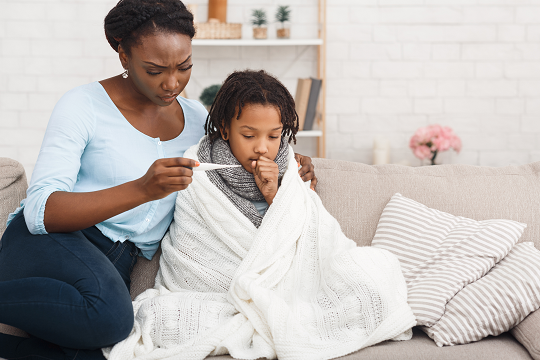Last update: 09/28/2021.
As life begins to feel like it’s returning to normal — kids are back in school, fans have returned to sporting events and concerts and more people are traveling — it’s still important to make sure we are taking steps to stop the spread of COVID-19. This is especially important for kids (under the age of 12) as they are not yet eligible to be vaccinated for COVID-19.
Unfortunately, proactive measures are made more difficult by the fact that COVID-19 has symptoms similar to the flu or common cold, including body aches, headache, scratchy throat, fever, cough or difficulty breathing, with added symptoms like loss of smell or taste.
COVID-19 testing helps stop the spread
Regardless of if your child has symptoms or not, regular COVID-19 testing is recommended for unvaccinated children who: attend in-person school or day care, or participate in activities that don’t allow for social distancing.
While at-home care won’t change dramatically with or without a positive test, the test result can help you determine recovery time and quarantine measures. According to the Minnesota Department of Health, regular testing can help identify new cases early, inform those who may have been exposed and keep the spread under control.
If your child has developed symptoms, get tested right away. If your child has had close contact with a confirmed case but has not developed symptoms, get them tested within five days of being exposed. Quarantine your child while you wait for your test results.
If you are looking for testing without a clinic visit, please seek testing-only options at retail pharmacies or the Minnesota Department of Health locations.
How to help your child recover at home
While COVID-19 can certainly be scary, most people, especially children, will likely have mild symptoms that can be managed at home. Follow these simple steps to help your child feel better quickly:
- The Centers for Disease Control and Prevention (CDC) recommends staying home and away from public spaces to prevent spreading the illness.
- Get plenty of rest and stay hydrated.
- Wash hands often with soap and warm water, for at least 20 seconds.
- Quarantine the ill child from the rest of the family as much as possible to prevent community spread.
- If it’s not possible to separate from the rest of the family, the sick child should wear a face mask.
- Cover all coughs and sneezes, then quickly toss used tissues into a lined trash can.
- Avoid sharing dishes, cups, towels and bedding.
- Clean and disinfect all high-touch surfaces thoroughly.
How long will symptoms of COVID-19 last?
There’s no way to tell exactly how long a person may feel sick if they have COVID-19. But here are some guidelines on when you can stop home isolation:
- Seven days have passed since the symptoms first appeared.
- Their cough and respiratory symptoms have improved.
- More than three days (72 hours) have passed since their last fever and no fever-reducing medications have been given.
If you have questions or concerns about how long your child has been ill, please contact their primary care provider.

Should I bring my child to the doctor?
If your child’s symptoms are mild, you can care for them at home. If you think medical care is needed, please call your primary care clinic before traveling to the emergency room or clinic. Your child’s pediatrician can instruct you on the best next steps.
What if my child’s symptoms get worse?
If your child begins to experience difficulty breathing or shortness of breath, please call their primary care provider at the clinic where they regularly receive care. If your child needs emergency care, call 9-1-1 and let them know they are showing symptoms of COVID-19 or have tested positive for COVID-19.
It’s essential to call ahead so health care teams can be prepared for your child’s arrival.
What if my child has an underlying condition?
Children with underlying health conditions are put at a higher risk of severe illness from COVID-19 and should avoid exposure to the illness by staying home, skipping out on group gatherings and not traveling. According to the CDC, the most common underlying conditions include obesity, diabetes, asthma or chronic lung disease, sickle cell disease, or immunosuppression.